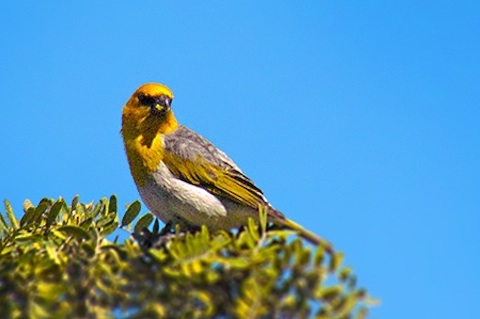|
"...E aha ana lā Emalani?E walea a nanea a‘e anai ka leo hone o ka Palila,ʻoia manu noho kuahiwi....""...What is it that Emalani is doing?Relaxing and enjoyingthe sweet voice of the Palila,those birds that dwell upon the mountain...."(from the 1882 song "He Inoa Pii Mauna no Kaleleonalani" about Queen Emma's visit to Mauna Kea) Why are Palila special?Palila are endemic, occurring only in Hawai‘i and nowhere else in the world. They are a classic example of the spectacular evolutionary process that occurred in the remoteness of the Hawaiian Islands where they survived in the dry forests for well over 100,000 years by adapting to a food source, māmane (Sophora chrysophylla) pods. The speciation that occurred in Hawai‘i dwarfs what was made famous by Charles Darwin in the Galapagos Islands where 14 species evolved from an original species. In Hawai’i, there were 55 species that evolved from the original species, most likely a Eurasian rosefinch that arrived from Asia. Palila belong to a group of birds called the Hawaiian Honeycreepers, which also includes ‘i‘iwi, ‘amakihi, and ‘akiapōlā‘au. Many (38 out of 55) of the palila’s relatives in this family have already gone extinct. In fact, of the 16 finch-billed Honeycreepers (species with heavy, seed-eating bills similar to the palila’s bill) that are known from the main Hawaiian Islands, all have gone extinct except the palila. Māmane trees provides over 90% of the food in the diet of palila, making them a specialist and highly dependent on māmane trees for their survival. Similar to the soybean pods that we eat, māmane trees produce pods with highly nutritious seeds for palila to eat. Interestingly enough, these seeds are poisonous to other wildlife. Their dependence upon māmane makes them an indicator species of the high-elevation dry forest, helping us monitor the health of the forest that they depend on. The decline of the palila population highlights that the forest is not healthy. The last remaining individuals are confined to a small portion of Mauna Kea. DLNR and their partners (The American Bird Conservancy, U.S. Fish and Wildlife Service, Natural Resources Conservation Service, Arbor Day Foundation, and hundreds of volunteers) are collaborating to restore māmane forests on Mauna Kea. We are fortunate to have the opportunity to restore the forest they depend upon in anticipation of a brighter future for this native bird. Palila belong here and are one of the things that makes Hawai‘i one of the most amazing places on the planet. ← Explore more about palila by viewing the tabs on the left. The Hawaiian Honeycreepers evolved from one ancestor into many diverse beak shapes, one of which includes the palila [image from "The Hawaiian Honeycreepers: Drepanidinae" by Douglas Pratt (2005)
Palila are the last of the finch-billed Hawaiian Honeycreepers left on the Main Hawaiian Islands. [image from "The Hawaiian Honeycreepers: Drepanidinae" by Douglas Pratt (2005) |

